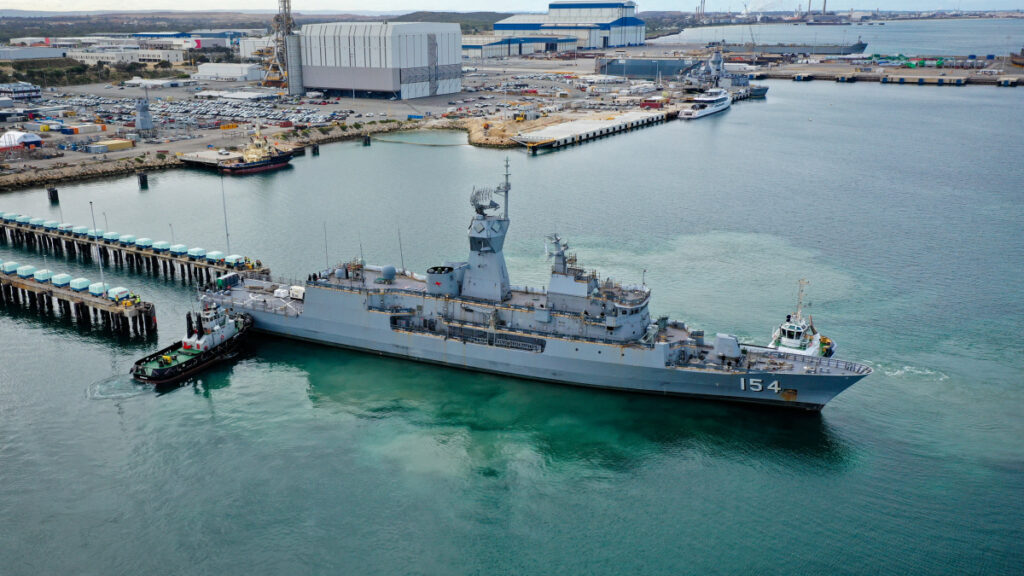The Space Force intends to first look at communications satellites as a pathfinder for establishing a Commercial Augmentation Reserve Fleet. (Image: Intelsat)
SPACE SYMPOSIUM — The Space Force today released its long-awaited Commercial Space Strategy, with a notable pledge to realign and reprioritize funding in order to support commercial opportunities.
The document, signed out by Chief of Space Operations Gen. Chance Saltzman and Frank Calvelli, assistant secretary of the Air Force for Space Acquisition and Integration, serves as a companion to DoD’s Commercial Space Integration Strategy, released April 2. While that earlier document laid out the broad guidance for where and why the Pentagon will try to increase its use of commercial space technologies, today’s document provides more details on how the Space Force will actually execute those ideas, particularly in the acquisition realm.
“We will leverage American industrial strength to counter threats to our advantages in space,” said Saltzman and Calvelli in a joint statement. “We owe it to American forces putting their lives on the line, to American businesses developing solutions to outpace the adversary, and to the American taxpayers expecting us to get the most out of their dollar.”
Notably, the language seems to include a pledge to put real money behind this effort, a long-standing complaint from commercial firms who feel DoD says all the right things but doesn’t put its budget behind it.
“Current funding levels and annual budgeting requests must evolve to achieve the desired end states,” reads the report. “As hybrid architectures are integrated into USSF force designs, budgets will be realigned and reprioritized to fully support their fielding. Likewise, as the CSS matures, the USSF will make any necessary organizational adjustments to fully leverage the operational benefits gained by hybrid architectures.”
That said, the Space Force’s fiscal 2025 budget request includes no money for a new commercial space funding pot.
Elsewhere, the report notes that future budget processes “will include more commercial space solutions. Funding will be allocated based on the strategic importance and urgency of missions within the USSF and priority will be given to mission areas critical for enhancing national security. This prioritization aligns with the USSF’s overarching objective of maintaining space superiority and protecting U.S. interests in the space domain.”
Per the report, there are eight broad mission areas considered for commercial support, each with specific capabilities being targeted:
Satellite Communications (SATCOM): Specifically, the Space Force seeks capabilities from the commercial sector that “increase and/or improve data transport speed, capacity, agility, flexibility, reliability, and/or resiliency and incorporate emerging technologies for the Joint Force to maintain competitive endurance.” Priority will be given to capabilities that are system agnostic in order to more quickly integrate into their platforms.
Space Domain Awareness (SDA): SDA is the basic mission of knowing what is in the heavens and where. The Space Force wants capabilities that can “contribute to the holistic generation of SDA.”
Space Access, Mobility, and Logistics (SAML): This mission area covers launch and support for launch. While the US government is already a major buyer of launch services, Space Force is interested in commercial capabilities including “launch services, flexible launch options, in-space servicing, and tactically responsive space capabilities that the Service can test, experiment with, and integrate into future missions.”
Tactical, Surveillance, Reconnaissance, and Tracking (TacSRT): Space Force’s new branding for the classic Intelligence, Surveillance, and Reconnaissance (ISR) acronym. The military branch seeks “broad surveillance services, planning products, data, transmission and fusion, and analytic capabilities from the commercial sector that can aid in the development and optimization of TacSRT functions in support of services and Combatant Commander objectives.” The language says “the USSF will continue to partner with the Intelligence Community to leverage existing capabilities where appropriate to ensure there is not duplicative effort” — a notable callout, given Breaking Defense’s previous reporting on clashes between Space Force and the IC over imaging.
Spacebased Environmental Monitoring (SBEM): This covers meteorological and oceanographic information, vital for Pentagon planners. Space Force wants “environmental monitoring capabilities from the commercial sector to characterize both terrestrial (via space-based sensing) and space environments (via both terrestrial and space-based sensing) to improve the resilience of terrestrial and space environmental monitoring architectures; inform Joint warfighter operational planners and decision makers; and improve the resilience of military systems to deliver warfighting effects and avoid operational surprises.”
Cyberspace Operations: A “foundational requirement” for space operations, this broad area is largely about protecting US assets both in orbit and on the ground. From the commercial sector, the Space Force wants the ability to provide mission assurance across all the parts of its communications chain. “This requires bold changes and technology development consistent with the DoD Zero Trust Framework and DoD Data, Analytics, and AI Adoption Strategy. The USSF seeks enduring partnerships and capabilities to enable a future of improved awareness and protection of the cyberspace domain with Allies and partners.”
Command and Control (C2): A core mission for every part of the DoD is ensuring that C2 is stable. For its part, the Space Force seeks capabilities from the commercial sector that increase C2 capacity and capability. The USSF will prioritize capabilities with dynamic technology (i.e. multi-band).”
Positioning, Navigation, and Timing (PNT): Most Pentagon systems require PNT — the ability to know exactly where and when you are — to operate correctly. Space Force wants “PNT capabilities from the commercial sector to enable operational resilience across the Joint Force and our Allies and partners. The USSF will test and evaluate these capabilities to inform on operational utilization across the spectrum of conflict.”
The priority areas identified in the report are TacSRT, SBEM, PNT and SAML. Those four represent, the report says, a demand signal to industry to show Space Force is serious about this.
The inclusion of PNT in the priority list is somewhat curious, given that the DoD commercial policy characterizes PNT as a mission that the Pentagon would be extremely cautious about turning over to industry.
“Supporting a broad industry base, while separate from operationally urgent needs, will be accounted for in the Service’s future funding requests to ensure competitive advantage,” the report also notes.
However, not everything will go commercial – with the Space Force strategy lining up behind the DoD policy’s close hold on missile warning, combat power projection, electromagnetic warfare and nuclear detonation detection. The Space Force strategy notes that none of these areas “currently” have commercial solutions being sought.
To make this all happen, the report identifies four key lines of effort, with an immediate goal attached to each:
Collaborative Transparency: This line effectively is promising to keep lines of communication open across the board, including with companies, think tanks, academic and industry associations. The immediate goal listed here is to “identify requirements that can, should, and will be met by commercial space solutions within each mission area,” and will work to integrate Guardians into the commercial sector to facilitate the conversation.
Operational and Technical Integration: This covers the development of policies, processes and procedures for the commercial sector to integrate fully into the Space Force and Joint Force. The immediate goal is to “ensure that there is a process to flexibly select commercial vendors to meet Joint Force operational needs.”
Risk Management: Space Force will work with companies to identify potential risks in their systems and provide “actionable, timely data” to aid with risk mitigation. The immediate goal is to establish a process of sharing threat information with the commercial sector, including space domain awareness and cyber threat information at “multiple classification levels” — something that will require working with DoD to remove overclassification of information, a drum that defense space leaders have been banging on for some time.
Secure the Future: Having an understanding of what technology is being developed and prioritizing science and technology efforts that will be operationally relevant. The immediate goal is to establish a process to “identify cross-cutting capabilities and services” for operational requirements, while working with groups like SpaceWERX, AFWERX and DIU.
In the report’s conclusion, the authors note that while there will be challenges and costs associated with this effort, it is ultimately where the Space Force needs to go.
“It is imperative that the USSF maximizes the integration of the disparate space capabilities on the ground and on-orbit, and fully leverages innovation in the commercial sector through the ‘exploit what we have, buy what we can, and build what we must’ approach to acquiring and fielding space capabilities.”
Theresa Hitchens contributed to this report.






![The sights from the 2024 Farnborough Airshow [PHOTOS]](https://centurionpartnersgroup.com/wp-content/uploads/2024/07/IMG_8722-scaled-e1721930652747-1024x577-hZjwVb-500x383.jpeg)




